
by Gwyn Conaway
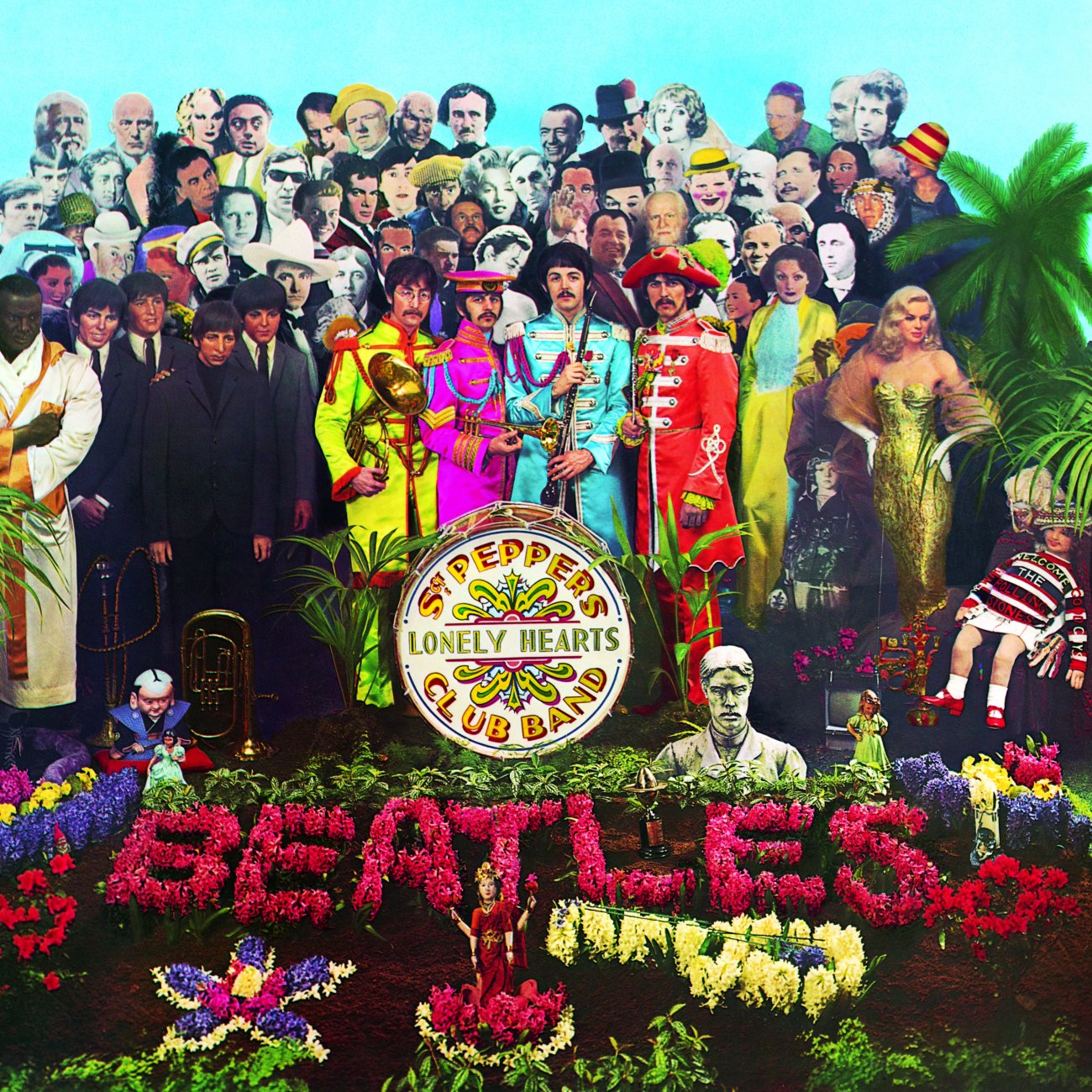
Sgt. Pepper's Lonely Hearts Club Band was released on May 27th, 1967 and has kicked off the album art era as well as bolstering the influence of psychedelic and progressive rock. This album is the flag ship of the Summer of Love.
The Beatles’ eighth album, Sgt. Pepper’s Lonely Hearts Club Band, was released two and a half weeks ago, and it continues to top the North American and European charts with no end in sight! The album is a fascinating journey from beginning to end, with a story woven into every aspect of the experience. This includes, of course, the costumes.
The album’s cover will live on in notoriety for decades, I’m sure. It’s colorful, optimistic, and draws from a rich history of live performance and influential figures. More than that, though, it’s a call to arms. Paul McCartney was inspired by Edwardian military bands for the title track, a concept which bled into the rest of the production, and when a theme such as this permeates an entire collection organically, it often suggests that the creators hit on a message of timely significance. With the Summer of Love upon us, The Beatles are setting themselves up as battlefield drummers leading an era of peace and optimism against modern warfare and exploitative economics.
A bold assumption on my part, I know. Let me convince you of my point of view.
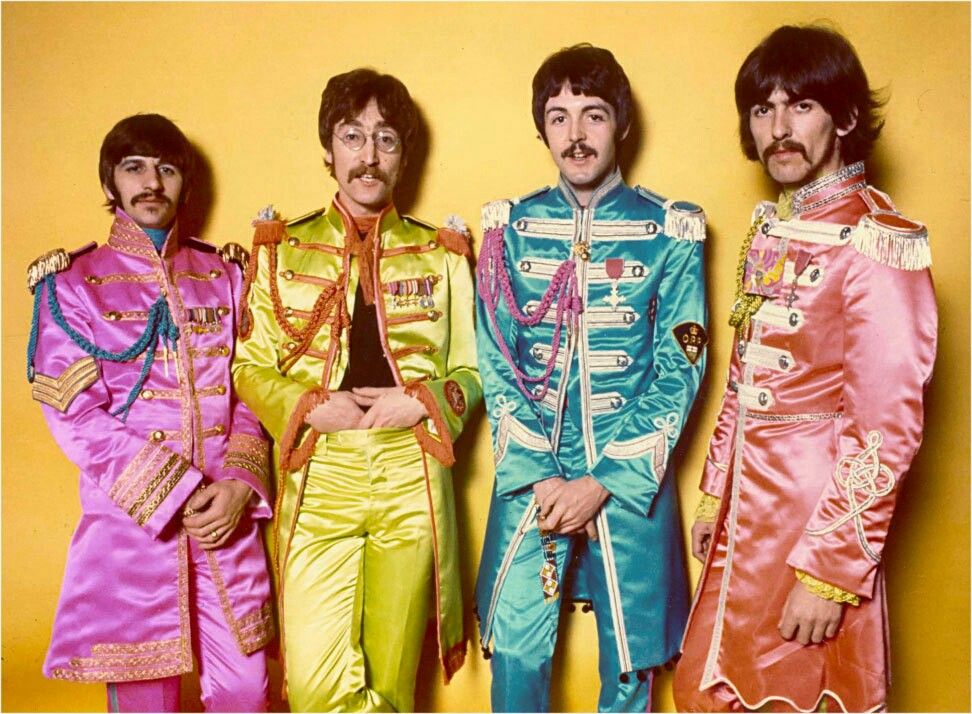
The Beatles in their Sgt. Pepper uniforms, designed by May Routh.
On the cover of Sgt. Pepper’s Lonely Hearts Club Band, the four band members are wearing neon color officers’ uniforms inspired by the military bands of WWI and standing behind an upright marching drum. These imaginative costumes were designed by May Routh as a celebration and a challenge. The celebration is the color palette, a symbol of mind-altering psychedelic drugs, and the materials, all shine and showmanship. The challenge, by comparison, is the blatant lack of attention to ranks and insignias. All four band members wear symbols of rank and power, but not in any way that pays homage to actual militaristic order. This is a conscious choice meant to commandeer the power and authority of wartime for a counter-culture defined by its vehement opposition to war.
At first, I thought this could be a direct mockery of the military, but then I considered that drum again, standing upright with the band turned in towards it. For over four thousand years, from China to the Americas, drums have been used on the battlefield as a way to keep in step, to make advances on the field, and to work in sync regardless of visibility. As recently as WWI, soldiers would time the reloading of their weapons to the beat of a drum. These brave drummers were often the first target of the opposing army. In the modern media, this analogy holds true: the monoliths of youth culture simultaneously lead the charge with the beat of their music and are subject to intense media scrutiny.
It's not a huge leap to see that The Beatles are calling on the world to embrace this new age, to fight back against injustice, war, and prejudice. Whether they’d planned to from the beginning, their message has become: Reload your hearts to the beat of our drum. The irony of using a militant image to convey an anti-war message has made their point of view far sharper, and is inspiring others to wield their visibility and influence – their drums, if you will – to the same end.

On the left, see a hussar in uniform astride his horse. The garment pictured center is a hussar's pelisse of the late 19th century, customarily worn over one shoulder as a mantle rather than a jacket. Note that Hendrix wears his pelisse as an open jacket and bare-chested.
Jimi Hendrix has also adorned himself in militaristic garments after his own experiences as a soldier. Hendrix has chosen the image of a royal hussar. These cavalry officers were prized for their unparalleled effectiveness on the battlefield for much of the past millennium, but disbanded after WWI in which they faced insurmountable odds. Regardless of being obsolete in the face of weapons of mass destruction, the hussars continue to be a symbol of militaristic supremacy and sophistication. By wearing an officer’s pelisse open over a bare chest, Hendrix supplants the power of the hussar and assumes their authority in defining himself as a sex symbol, an effortless master on the guitar, and icon of the Summer of Love. He challenges the role of The Beatles as the generals of the New Age while leading his own troops onto the battlefield of cultural change.

Left, a drummer boy of the 1st Scots Guard. Flaunting the same rules of rigmarole as The Beatles and Jimi Hendrix, Mick Jagger is wearing the uniform as if it's a casual garment.
The boldest (or perhaps the most blunt) symbol of the anti-war, peace-loving army, is Mick Jagger, who is also this year wearing the uniform coat of a drummer boy of the 1st Scots Guard. Let’s remember the call to arms in the drum of the Sgt. Pepper’s Lonely Hearts Club Band album cover. Their choices of fashion and costume aren’t coincidental. These rock stars are gathering their army to affect change in society.
They also reach beyond the military, looking to symbols of wealth and sex, redefining upperclass fantasies as symbols of equality and empathy. They dress in frock coats and cravats rather than suits and ties. The Hippie Movement even denies the use of modern notions, such as snaps and zippers, in favor of simple cords or buttons.
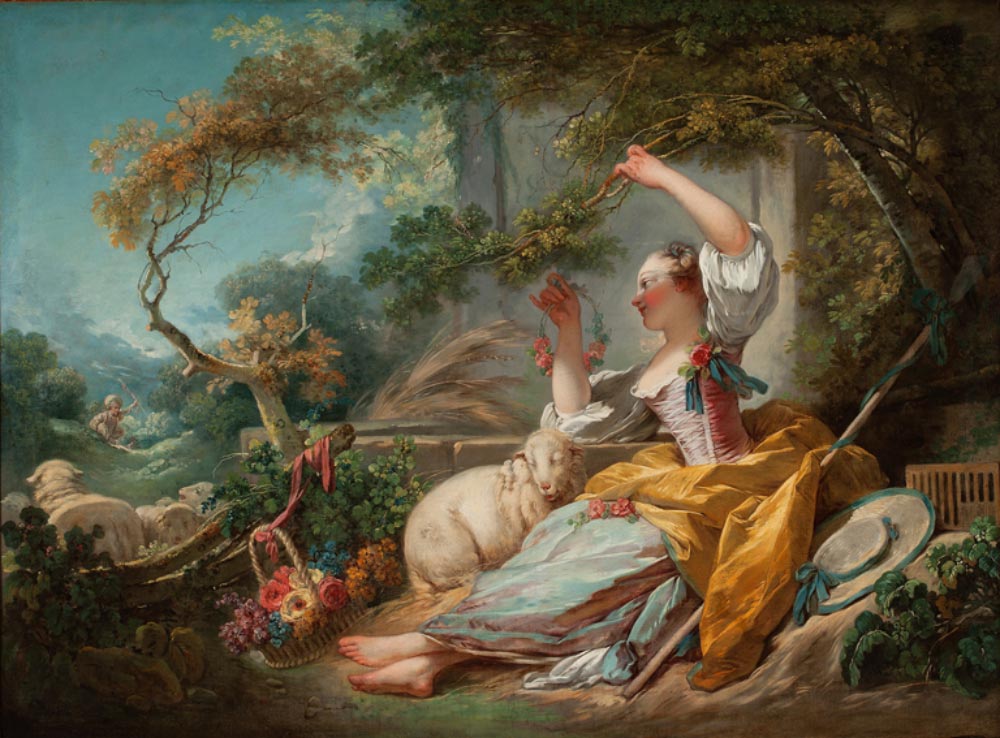
Jean-Honoré Fragonard, The Shepherdess, ca. 1750/52. This is a pastorale genre painting of the French court which glorifies the countryside life without acknowledging their struggles. The genre of painting is now a symbol of how tone-deaf the French courts had become to their people's strife.

Marie Antoinette's le Petit Hameau on the grounds of Versailles.
As a historian, I see a direct correlation between these choices and the pastorals of Rococo France in the 18th century (back when buttons were fairly modern technology). Before the French Revolution, the nobility romanticized a countryside, working class life, glorifying shepherdesses and minstrels, farmers and hunters. Marie Antoinette’s le Petit Hameau is the perfect example: an extremely expensive designer cottage based on rural French homes, in which she held exclusive soirees and fed impeccably groomed farm animals as an escape from the pressures of the royal court. Fashion and portraits played a big role in this blind fantasy of the nobility as well.
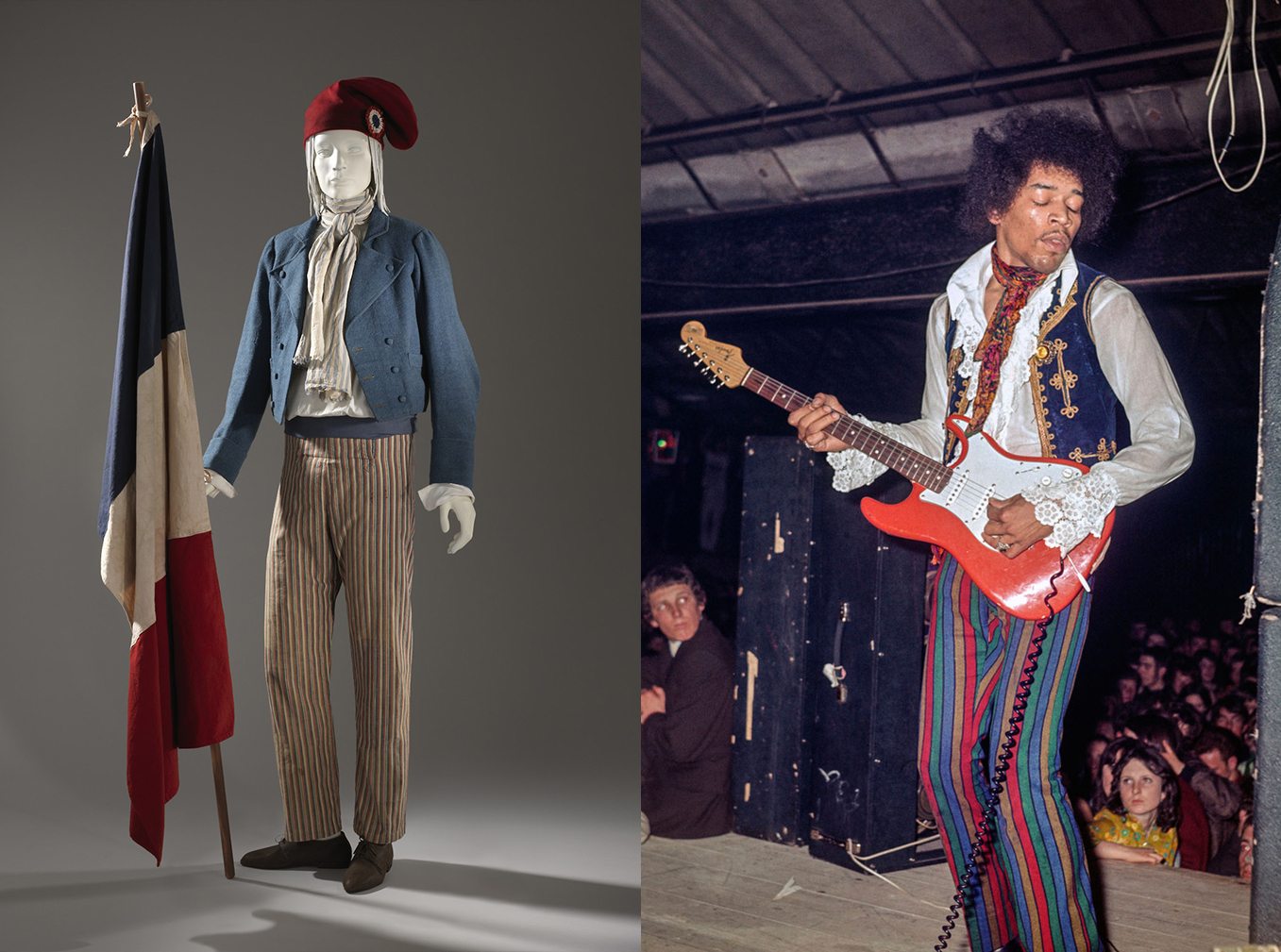
Jimi Hendrix often wears stripes, frothy necklines, cravats, and even a carmagnole jacket. The carmagnole was a symbol of the French Revolution. Striped pantaloons and a loose cravat were also symbols of the Sans Culottes (or anti-nobility) movement of the late 18th century. Interestingly, this type of cravat was popular in France because of the Battle of Steenkerque, in which French troops were taken by surprise and had no time to tie their cravats properly. The French won the battle, making a disheveled cravat immensely popular thereafter.
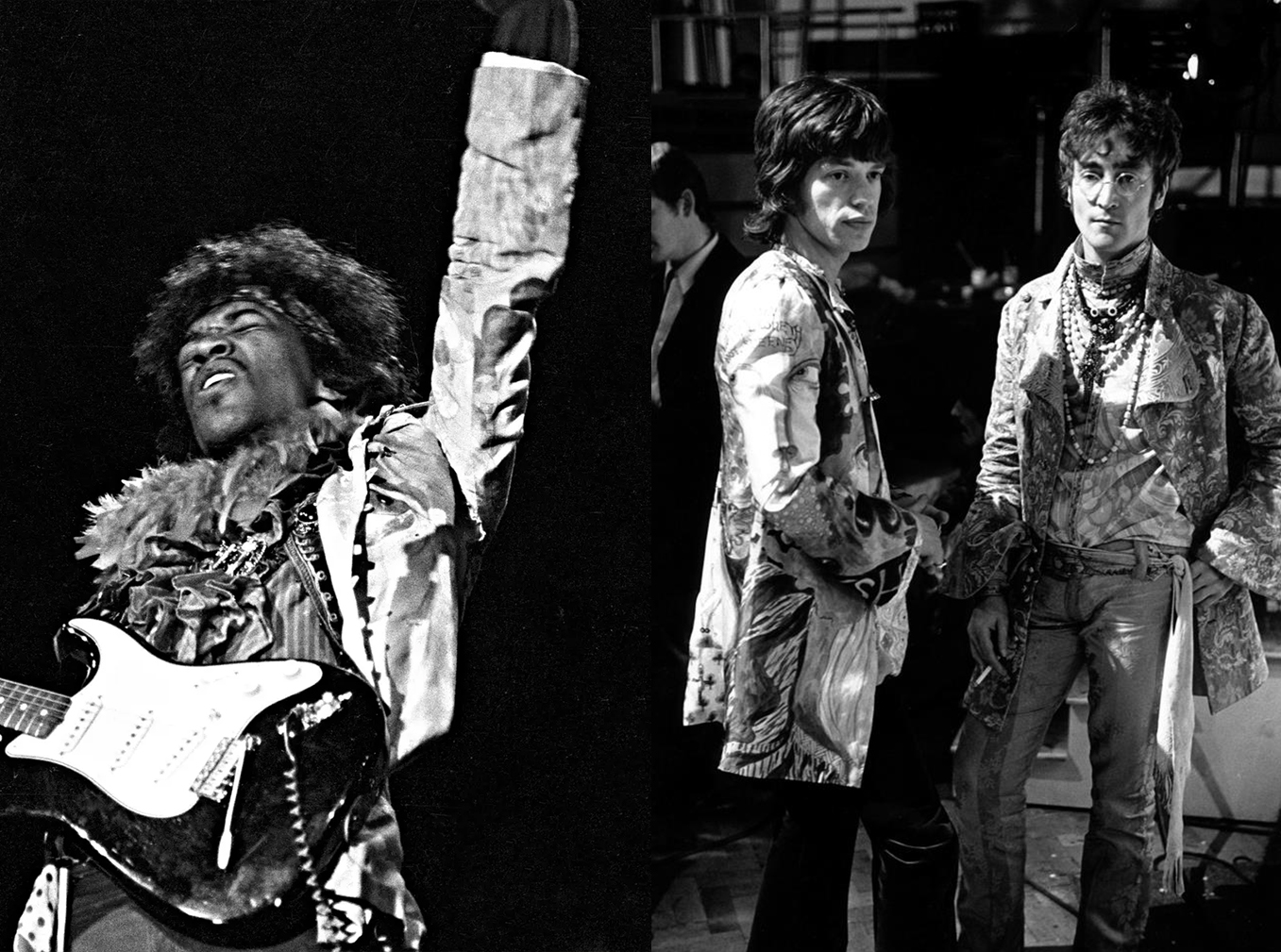
Left, Jimi Hendrix in a carmagnole, stripes, and frothy neckline. Right, Mick Jagger and John Lennon bedecked in frock coats inspired by the habit à la française, menswear of the French courts in the 18th century.
How does that relate to the music scene of the Summer of Love? It’s no different than using militaristic imagery to disseminate an anti-war message and ridicule the institution. These musicians that speak directly to the youth movement are pulling down images of traditional wealth, power, and escapism to the level of working class people. The intent is to break down the barriers of social propriety and offer an alternative to the machine of tradition. They fully believe that their message of equality and empathy is more powerful than money or gender or race or religion. They are anti-wealth, and so equalize the symbols of wealth. They are anti-corporate, and so dishevel men's suits and grow their hair long. They are anti-division, and so adopt softer fabrics, lace, and makeup to challenge the definition of masculinity and femininity.
Mark my words, a cultural revolution is underway, and the generals at the forefront of the war know how to use the establishment’s symbols against them. Extremely narrow and rigid views on issues such as gender, race, and national identity are going to be challenged in the years to come. What an exciting and volatile time! Now excuse me while I flip my album over.


![[June 18, 1967] Sgt. Pepper's Anti-War Military Rock Uniform](https://galacticjourney.org/wp-content/uploads/2022/06/5459197-HUTPCWVK-7-672x372.jpg)
